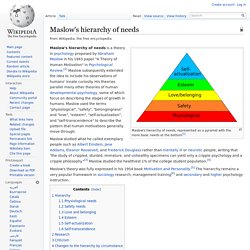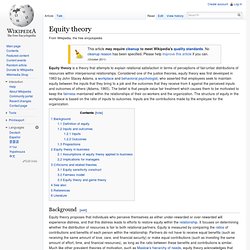

Metamotivation. Category:Motivational theories. Backward bending supply curve of labour. This labour supply curve shows how the change in real wage rates affects the number of hours worked by employees.

In economics, a backward-bending supply curve of labour or backward-bending labour supply curve is a graphical device showing a situation in which, as "real" or inflation-corrected wages increase beyond a certain level, people will substitute leisure (non-paid time) for paid work-time and thus higher wages lead to less labor-time being offered for sale.[1] The "labor-leisure" tradeoff is the tradeoff faced by wage-earning human beings between the amount of time spent engaged in wage-paying work (assumed to be unpleasant) and satisfaction-generating non-paid time that allows (1) participation in "leisure" activities and (2) use of time to do necessary self-maintenance, such as sleep.
AJPS2000FinalText.PDF - SocialDilemma.pdf. Meta-Motivation Inventory. The Meta-Motivation Inventory Perhaps one of the most fascinating adventures that people share is the process of self-discovery.

It is the knowledge of self, derived from increasing self-awareness in this exciting life process of learning and growth that provides the means of developing and exercising our full potential. The Meta-Motivation Inventory was designed to assist in assessing your progress in this process of growth, providing feedback on your characteristic personal, management and leadership styles. The Inventory can be administered and debriefed during a seminar providing participants with valid and reliable feedback on thirty-two personality dimensions contained in the following six major categories. Table_basic_desires.jpg (Image JPEG, 2480x3508 pixels) - Redimensionnée (22%) Point de basculement dans l’adoption d’idées. Un point de basculement sociologique ou tipping point en anglais est le moment à partir duquel le comportement ou une conviction d’un groupe de personnes finit par être adopté par plus de la moitié de la population.

Des chercheurs à l’Institut Polytechnique de Rensselaer aux Etats-Unis ont découvert que le point critique de basculement pour l’adoption d’idées se situait à 10%. How to get involved - Networked Advocacy. From Networked Advocacy How to get involved Send an email to kearns AT greenmediatoolshed.org with network Advocacy wiki in the subject line.

Tell me about your experience as it relates to what you want to do on the project and how much time you might be able to kick in to help. We are looking for people to: Review content Garden (clean and organize content) Interview practitioners, experts and advocates "Road test" parts of the content to give us more feedback Help us make sure the content is accessible to wide audiences Add multimedia like photos and Youtube - to make the wiki look less wiki Fund testing of the training program Why a Wiki?
Quite simply, it is the simplest online database that can work It's open and any reader can edit it as they see fit. People to Review Content Does the content page make sense to you. Human Evolution and Distinctively Human Motivation. Distinctively human motivation and another view on human evolution Ecomon Ltd.

Moscow, Russia Abstract Human evolution is a multidisciplinary problem, one of its aspects is the origin and development of distinctively human psychological features. Cognitive properties (language, symbolic thinking) are considered as such features and numerous authors hypothesize its evolution. A Language for the Future. Editor’s note: In this article Pella Thiel introduces us to the Common Cause report and related psychology and linguistics research on how values work.

This research shows that the way we talk about the issues we care about is, in fact, very important. A version of this article was originally published in the Swedish magazine effect, nr 1 2013. Dan Pink: The puzzle of motivation. RSA Animate - Drive: The surprising truth about what motivates us. Maslow's hierarchy of needs. Maslow's hierarchy of needs, represented as a pyramid with the more basic needs at the bottom[1] Maslow's hierarchy of needs is a theory in psychology proposed by Abraham Maslow in his 1943 paper "A Theory of Human Motivation" in Psychological Review.[2] Maslow subsequently extended the idea to include his observations of humans' innate curiosity.

His theories parallel many other theories of human developmental psychology, some of which focus on describing the stages of growth in humans. Maslow used the terms "physiological", "safety", "belongingness" and "love", "esteem", "self-actualization", and "self-transcendence" to describe the pattern that human motivations generally move through. Maslow's theory was fully expressed in his 1954 book Motivation and Personality.[5] The hierarchy remains a very popular framework in sociology research, management training[6] and secondary and higher psychology instruction.
Hierarchy. Abraham Maslow's Hierarchy of Needs and diagrams of Maslow's motivational theory - pyramid diagrams of Maslow's theory. Home » leadership/management » maslow's hierarchy of needs Abraham Maslow's Hierarchy of Needs motivational model Abraham Maslow developed the Hierarchy of Needs model in 1940-50s USA, and the Hierarchy of Needs theory remains valid today for understanding human motivation, management training, and personal development.

Indeed, Maslow's ideas surrounding the Hierarchy of Needs concerning the responsibility of employers to provide a workplace environment that encourages and enables employees to fulfil their own unique potential (self-actualization) are today more relevant than ever. Abraham Maslow's book Motivation and Personality, published in 1954 (second edition 1970) introduced the Hierarchy of Needs, and Maslow extended his ideas in other work, notably his later book Toward A Psychology Of Being, a significant and relevant commentary, which has been revised in recent times by Richard Lowry, who is in his own right a leading academic in the field of motivational psychology. (N.B. Pyramide ou roue de Maslow ? Pyramide des besoins de Maslow. » Maslow's Theory of Motivation - Hierarchy of Needs. Quatorze besoins fondamentaux selon Virginia Henderson. Un article de Wikipédia, l'encyclopédie libre.

Les quatorze besoins fondamentaux représentent un modèle conceptuel en sciences humaines et notamment en soins infirmiers. Ils font partie des courants de pensée infirmière et sont proposés par Virginia Henderson depuis 1947[1]. La vision de l'interdépendance des besoins humains et de leurs satisfactions, issue de la pratique de Virginia Henderson, est fortement marquée par le courant behavioriste. Enseigné durant les études en soins infirmiers, le concept des quatorze besoins fondamentaux se base notamment sur l'expérimentation personnelle[2],[3]. Description du modèle[modifier | modifier le code] Selon le modèle de Virginia Henderson, les besoins fondamentaux de l'être humain peuvent être classés selon une liste ordonnée que les professionnels de santé utilisent lors des soins d'une personne malade ou en bonne santé.
Selon ce modèle, tous les besoins sont à considérer avec la même attention. Utilisation[modifier | modifier le code] Equity theory. Equity theory is a theory that attempts to explain relational satisfaction in terms of perceptions of fair/unfair distributions of resources within interpersonal relationships.

Considered one of the justice theories, equity theory was first developed in 1963 by John Stacey Adams, a workplace and behavioral psychologist, who asserted that employees seek to maintain equity between the inputs that they bring to a job and the outcomes that they receive from it against the perceived inputs and outcomes of others (Adams, 1965). The belief is that people value fair treatment which causes them to be motivated to keep the fairness maintained within the relationships of their co-workers and the organization. The structure of equity in the workplace is based on the ratio of inputs to outcomes.
Tit for tat. In Western business cultures, a handshake when meeting someone is an example of initial cooperation. Tit for tat is an English saying meaning "equivalent retaliation". It is also a highly effective strategy in game theory for the iterated prisoner's dilemma. Two Monkeys Were Paid Unequally: Excerpt from Frans de Waal's TED Talk. Les 3 piliers de la motivation intrinsèque. Avez-vous parfois l’impression que vos supérieurs vous manipulent au bâton et à la carotte, c’est-à-dire à coup de punitions et de récompenses ? Si l’époque de la révolution industrielle dénoncée par le film “Les temps moderne” est bel est bien derrière nous, certaines méthodes modernes de management laissent pourtant à désirer.
C’est peut-être même de pire en pire si l’on en croit l’actualité des affaires liées à la souffrance au travail. Et la pression sur les employés ne semble pas prête à se relâcher vu les défis récurrents auxquels est soumise notre économie aux prises avec la mondialisation. Depuis Maslow, le père de la psychologie humaniste, nous avons pourtant appris que le plaisir au travail est une condition essentielle pour motiver le travailleur intellectuel.
C’est le concept de motivation intrinsèque. Dans cet article, je vous propose d’explorer ensemble trois besoins nécessaires à la motivation intrinsèque pour enfin apprécier vos journées de travail au lieu de les subir… 1. 5 Non-material incentives that can motivate your employees. There are two types of incentives that managers can use to motivate their employees: material and non-material. The material ones refer to incentives like salary, bonuses and other types of material rewards or sanctions that a company can give to the employees. The non-material incentives are related to the feelings, values and behavior of the employees. The non-material incentives give to the person the reason why he should do a certain task, while the material incentives strengthen the reasons by assimilating to the rewards numbers and other benefits.
According to the specialists the non-material incentives are the ones that really make the people do a certain task and keep them focused on long-term. Incentive. An incentive is something that motivates an individual to perform an action. The study of incentive structures is central to the study of all economic activities (both in terms of individual decision-making and in terms of co-operation and competition within a larger institutional structure).
Economic analysis, then, of the differences between societies (and between different organizations within a society) largely amounts to characterizing the differences in incentive structures faced by individuals involved in these collective efforts. Ultimately, incentives aim to provide value for money and contribute to organizational success. [ 1 ] Influence & ranking. Motivational & Inspirational Quotes. The 5 Step Process to Develop Life Long Motivation. Motivation is often cited as the magical answer to everything you want. If you were motivated you would lose that weight, write that book, start the business and so on. So how do we develop the habits and mind power needed to stay motivated on a daily basis? Here is my 5 Step Process to Develop Life Long Motivation. But, here’s a question: What if motivation never strikes? What are you going to do then?
Is Motivation The Solution? I often hear people say “if I could just find the motivation to…” Within these words are an implication. If you were motivated you would pay off that debt, find a new job, and go back to school. But what if that’s not the case? What if motivation isn’t the solution? Can Money Buy Innovation? Even in our money-driven society, the power of money has limits: there are certain things money can’t buy. Love and happiness come to mind first, but a popular list of things that can’t be supposedly bought with money is much longer and includes such items as “25-hour day,” “clear conscience” and (my favorite) “an honest politician.” Some would add one more item to this list: innovation. Innovation, they’d argue, is a thing based on creativity, and creativity feeds on intrinsic motivators: natural curiosity, joy of learning, thrill of solving a difficult problem.
Extrinsic motivators, such as money, can do little to make a person more creative. Hence, the argument goes, money can’t buy innovation. Unfortunately, academic research on incentivizing innovation is still in its infancy and doesn’t provide much help. Hopefully, future research will bring more clarity to the topic. (Images) 43 Of The Most Popular Motivation Picture Quotes. Home > Motivation > (Images) 43 Of The Most Popular Motivation Picture Quotes By Joel Brown on August 12, 2013 Motivation Quotes are an essential to feed your daily need for inspiration. They inspire us to be greater than we are right now, to push through the obstacles and break through our limitations. Incentives & Regulation. Motivation. Motivation has been shown to have roots in physiological, behavioral, cognitive, and social areas.
Motivation may be rooted in a basic impulse to optimize well-being, minimize physical pain and maximize pleasure. It can also originate from specific physical needs such as eating, sleeping or resting, and sex. Motivation is an inner drive to behave or act in a certain manner. These inner conditions such as wishes, desires and goals, activate to move in a particular direction in behavior.
Category:Motivation. Motivation-Infographic.jpg 5104x3298.